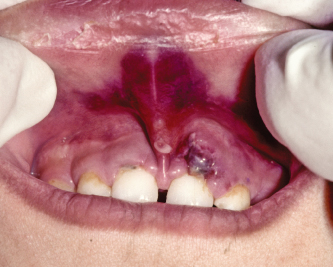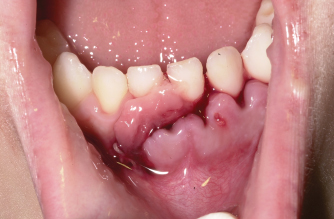27
Assessment of Trauma in Children
Frequency of Trauma in Children
- 30% suffer injury to the primary dentition.
- 22% injure their permanent teeth.
- Peak incidence 2–4 years and then at 8–10 years.
- Male : female ratio, 2 : 1.
- Overjet 3–6 mm – twice the frequency of trauma; >6 mm – threefold increase.
Child Management
It is important to assess early how the child is going to cope with the required treatment. In the emergency situation, it is easy to concentrate on all the procedures that are required and forget about appropriate child management and the concerns of the parents.
- Can the child cope with the procedure?
- Non-pharmacological behaviour management techniques.
- Pharmacological techniques:
- relative analgesia;
- sedation – oral, nasal, rectal, IV;
- general anaesthesia.
Principles of Primary Care
It is essential to take the time to take a thorough history and completely examine the child. This is especially important in assessing long-term prognosis and may be important in litigation.
- Accurate history:
- Are there any medical co-morbidities?
- Did the child sustain any other injuries?
- Was there a loss of consciousness?
- Prognosis of injuries.
- Litigation.
- Thorough examination of the head and neck and any other areas that sustained trauma. Examine both extra-oral and intra-oral.
History
Questions to ask:
- When and how did the trauma occur?
- Were there any other injuries sustained?
- What initial treatment was given?
- Have there been other dental injuries in the past?
- Is the child fully immunised against tetanus?
Examination
- Extra-oral:
- facial skeleton, skull and facial bones;
- soft tissues – lacerations, grazing etc. (Figs. 27.1 and 27.2);
- assessment of cranial nerves.
- Intra-oral:
- soft tissues – lacerations, degloving;
- fractures or displacement of bone;
- displacement and damage to teeth;
- alterations in the occlusion;
- mobility, pulp exposure, percussion;
- pulp sensibility testing.
Figure 27.1 Soft tissue injury to the labial fraenum. This is a common injury and non-accidental injury should not be discounted.

Figure 27.2 Gingival laceration and degloving from blunt trauma.

Stay updated, free dental videos. Join our Telegram channel

VIDEdental - Online dental courses


